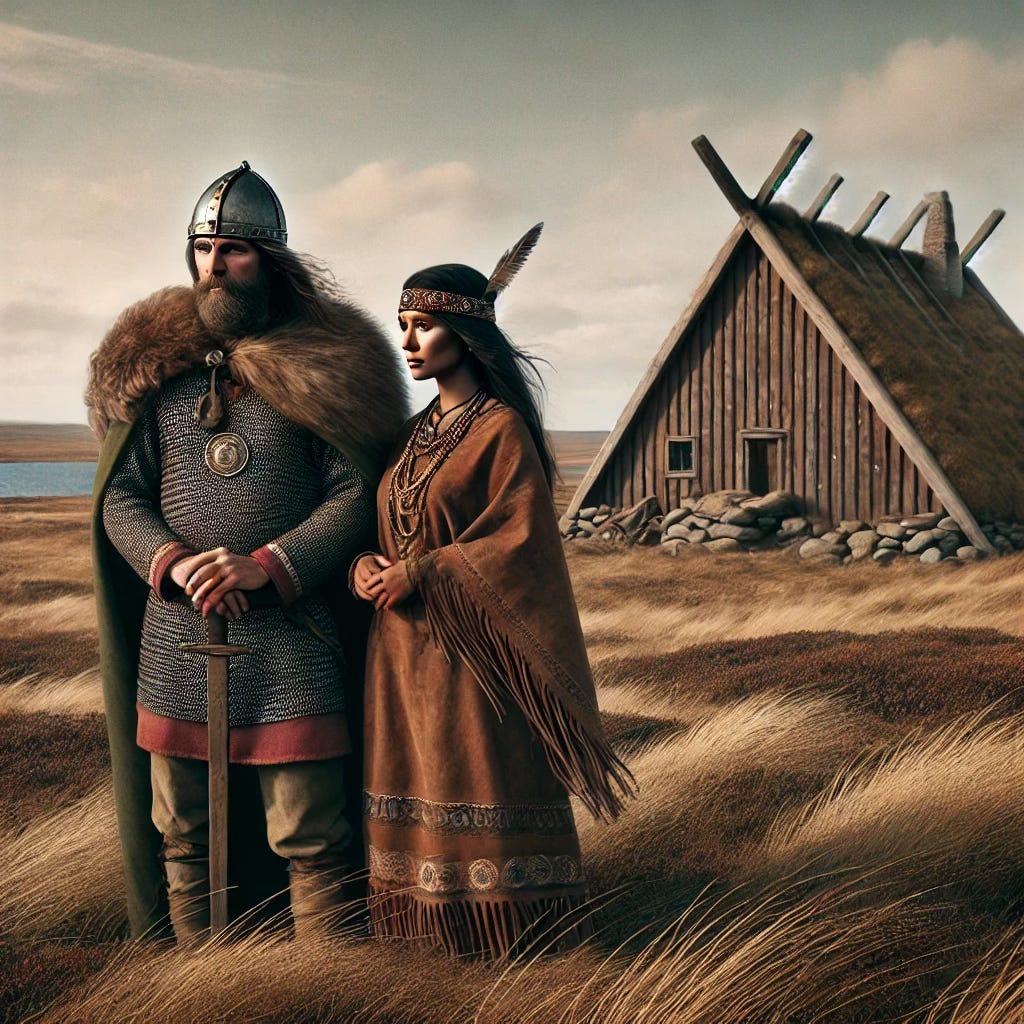Did Vikings Have a Pocahontas? An Obscure Study's Surprising Find
Exploring the Possibility of Viking-Native American Intermixing Through a Forgotten Genetic Study
The Vikings were known for their extraordinary voyages, expanding their influence as far as Baghdad in the Middle East and Newfoundland in North America. Their adventurous spirit left behind a trail of raiding, trading, and genetic legacy. Given their prolificness as progenitors across Europe, one question has intrigued me for a number of years: did the Vikings intermix with Native Americans during their explorations of North America?
This question takes us deep into the annals of Viking history, from the Greenland Norse who attempted colonization in North America to a curious genetic study suggesting a possible intermingling of Viking and Native American ancestries. Let’s dive into the evidence and unravel this fascinating possibility.
Viking Voyages to North America: The Greenland Norse
The story of Viking exploration in North America begins with Erik the Red and the Greenland Norse. Exiled from Iceland for manslaughter, Erik settled in Greenland in 985 AD. Over the following centuries, Greenland became a hub for Norse exploration, with tales of fertile lands to the west sparking voyages to what we now know as North America.
Leif Erikson, Erik’s son, is credited with leading the first expedition to these new lands. The sagas describe their discovery of Helluland (likely Baffin Island), Markland (likely Labrador), and Vinland, a region rich in timber and wild grapes. Archaeological evidence, such as the Norse settlement at L’Anse aux Meadows in Newfoundland, confirms the presence of Viking activity in North America around 1000 AD.
However, the sagas also recount tense relations between the Greenland Norse and the Native Americans, whom they called Skrælings. Initial trade between the two groups led to hostilities, with the Norse abandoning their settlements due to conflict and isolation. The sagas depict the Skrælings in a highly dehumanized light, often as subhuman adversaries. This attitude is exemplified in incidents where the Greenland Norse slaughtered Skrælings with impunity, such as the account of encountering sleeping Skrælings and killing them outright. These descriptions in the sagas highlight the likelihood of a hostile and dismissive relationship, which has long led historians to doubt significant intermixing between the two groups.
The Genetic Evidence: A Surprising Discovery
Fast forward to 2011, when a team led by Agnar Helgason of deCODE Genetics uncovered intriguing genetic evidence that may shed light on this historical mystery. Published in the American Journal of Physical Anthropology, their study identified a mitochondrial DNA (mtDNA) lineage, haplogroup C1e, in over 80 living Icelanders. This lineage is distinct from the known European genetic pool and resembles haplogroups in Native American and East Asian populations.
Mitochondrial DNA, passed down through the maternal line, provides a unique lens into ancestry. The presence of C1e in Iceland suggests that a Native American woman might have been brought to Iceland by Norse explorers. Further genealogical analysis traced this lineage back at least 300 years, with evidence pointing to an earlier introduction, possibly during the Viking Age.
What Does Haplogroup C1e Reveal?
The researchers sequenced the complete mtDNA genome of 11 contemporary carriers of haplogroup C1e, revealing a new subclade not belonging to any of the known Native American or Asian subclades (C1b, C1c, C1d, or C1a). This subclade, dubbed C1e, is presently unique to Iceland. While a Native American origin is most likely, an Asian or European origin cannot be entirely ruled out due to the lack of comparative data.
Interestingly, the genealogical database used in the study indicated that the C1e lineage likely entered Iceland’s gene pool centuries before 1700, possibly during the era of Viking exploration. If this is true, it raises the tantalizing possibility that Norse voyages to North America led to the transportation of at least one Native American woman to Iceland. This leads us to an intriguing possibility: could there have been a ‘Viking Pocahontas’?
Historical and Archaeological Context
While the genetic evidence is compelling, it’s essential to consider the historical and archaeological context. Though invaluable historical sources, the sagas provide no direct evidence of intermarriage or partnerships between the Norse and Native Americans. On the contrary, they often depict the Skrælings in a dehumanizing light, emphasizing conflict rather than cooperation.
Archaeological findings at L’Anse aux Meadows and other Norse sites in Greenland show evidence of trade between the Norse and Native populations, such as the presence of butternuts that grow further south in North America. However, there is no clear evidence of long-term interaction or integration of these groups.
Could It Have Happened?
Given the Vikings’ proclivity for forming relationships in foreign lands, it is not implausible that a Greenland Norseman could have taken a Native American woman as a partner during their brief sojourns in North America. Such an event, while rare, could explain the presence of haplogroup C1e in Iceland’s genetic pool. However, the lack of corroborating evidence in the sagas or archaeology suggests that if it did happen, it was an isolated incident rather than a widespread practice. Hence the reference to Pocahontas, which is a historical parallel whereby she returned to England with John Smith.
Implications and Future Research
The discovery of haplogroup C1e opens new avenues for exploring Viking history and their interactions with other cultures. It also underscores the complexity of genetic ancestry and the need for further research. Could additional genetic studies uncover more evidence of intermixing? Might archaeological discoveries provide new insights into Norse-Native relations?
One exciting prospect is the potential for ancient DNA analysis of skeletal remains from Norse sites in Greenland and Iceland. Such research could confirm whether Native American ancestry existed in these populations during the Viking Age.
Conclusion: A Singular Connection?
The evidence for Viking-Native American intermixing remains inconclusive but intriguing. The discovery of haplogroup C1e in Iceland suggests that such a connection is possible, albeit rare. Future research will answer whether this represents a singular event or the tip of a historical iceberg.
As a writer of historical fiction, I find the implications of these genetic findings endlessly intriguing. The potential for stories that weave together the lives of Norse explorers and Native Americans opens the door to a largely unexplored narrative frontier. What might it have been like for a Native American woman to journey to Iceland, leaving her homeland behind to navigate a vastly different culture and climate? How would such an encounter have shaped the lives of the Greenland Norse? These questions ignite the imagination, begging for the careful exploration and humanization that only historical fiction can provide. I would love to see a skilled storyteller bring this possibility to life, crafting a compelling narrative that bridges these worlds and sheds light on what history might not have recorded.
For now, the saga continues, blending history, archaeology, and genetics into a fascinating narrative that reminds us of the Vikings’ enduring legacy—not just as explorers and settlers but also as agents of cultural and genetic exchange.
References and Further Reading:
Ebenesersdóttir, S. S., et al. (2011). "A new subclade of mtDNA haplogroup C1 found in Icelanders: Evidence of pre-Columbian contact?" American Journal of Physical Anthropology. Link to study




